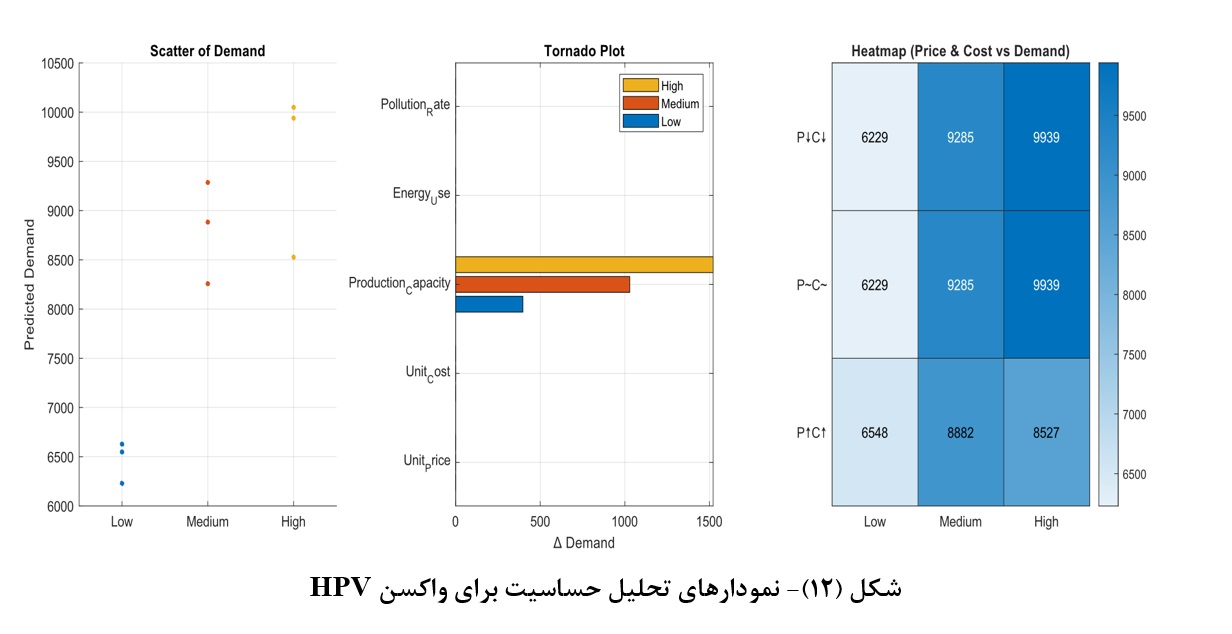Mathematical Modeling of Data-Driven Multi-Objective Production Planning with Machine Learning in the Biopharmaceutical Industry: Integrating Demand Forecasting and Sustainable Optimization
Keywords:
data-driven production planning, biopharmaceutical industry, multi-objective model, artificial neural network (ANN), Long Short-Term Memory (LSTM), Genetic Algorithm (GA), Particle Swarm Optimization (PSO)Abstract
The biopharmaceutical industry, as one of the most advanced sectors of the modern pharmaceutical field, faces multiple challenges such as demand fluctuations, resource constraints, complex manufacturing processes, and environmental requirements. In this context, data-driven and intelligence-based approaches can play a key role in improving decision-making accuracy, sustainability, and profitability. This study aims to develop a comprehensive framework for sustainable production planning by integrating demand forecasting with multi-objective mathematical modeling. In the first step, real data for nine selected drugs were collected over a 36-month period and used to forecast demand patterns through Artificial Neural Networks (ANN) and Long Short-Term Memory (LSTM) networks. The results showed that the ANN model, with a Root Mean Square Error (RMSE) of 868, was able to reconstruct demand trends with moderate accuracy, while the LSTM model estimated average demand with an error of less than 1% at the drug–scenario level. In the second step, a multi-product and multi-objective mathematical model was designed to simultaneously address economic goals (profit maximization and cost reduction) and environmental goals (pollution and waste minimization). To solve the model, Genetic Algorithms (GA) and Particle Swarm Optimization (PSO) were applied in combination with the epsilon-constraint method to extract the Pareto front. The findings revealed that GA had relative superiority in faster convergence, whereas PSO performed better in broad exploration of the solution space. Moreover, multivariate sensitivity analysis indicated that production capacity, raw material cost, and emission rates have the greatest impact on the results. By bridging the gap between demand forecasting and production optimization, this research provides a practical framework for intelligent decision-making in Iran’s biopharmaceutical industry and can contribute to supply chain resilience, cost reduction, and achieving sustainable development goals.
References
Ahmed, M. M., et al. (2020). An Environmentally Sustainable Closed-Loop Supply Chain Network. Design under Uncertainty: Application of Optimization..https://doi.org/10.48550/arXiv.2009.11979
Brownlee, J. (2018). Deep Learning for Time Series Forecasting: Predict the Future with MLPs, CNNs and LSTMs in Python. Machine Learning Mastery.
Bertsimas, D., Gupta, V., & Kallus, N. (2018). Data-driven robust optimization. Mathematical Programming, 167(2), 235–292. https://doi.org/10.1007/s10107-017-1125-8
Deb, K., Pratap, A., Agarwal, S., & Meyarivan, T. (2002). A fast and elitist multiobjective genetic algorithm: NSGA-II. IEEE Transactions on Evolutionary Computation, 6(2), 182–197. IEEE. https://doi.org/10.1109/4235.996017.
Daniel Alejandro Rossit, Fernando Tohmé, Mariano Frutos,(2019),A data-driven scheduling approach to smart manufacturing,Journal of Industrial Information Integration,Volume 15,Pages 69-79. https://doi.org/10.1016/j.jii.2019.04.003
Emami H, radfar R, emami F. (2018).Commercialization Modeling and Processes in Pharmaceutical Industry: A Case Study of Presenting an Evaluation Pattern Using Dynamic Programming Model. Hakim; 21 (3):211-220. URL: http://hakim.tums.ac.ir/article-1-1551-en.html
Grand View Research. (2023). Biopharmaceuticals Market Size, Share & Trends Analysis Report. https://www.grandviewresearch.com
Gama, F., Wang, S. (2024). Data-Driven Robust Production Planning. In: Facility Location Under Uncertainty. International Series in Operations Research & Management Science, vol 356. Springer, Cham. https://doi.org/10.1007/978-3-031-55927-3_16
Hu, F., Zhang, L., & Wang, J. (2024). A Hybrid Convolutional–Long Short-Term Memory–Attention Framework for Short-Term Photovoltaic Power Forecasting, Incorporating Data from Neighboring Stations. Applied Sciences, 14(12), 5189. https://doi.org/10.3390/app14125189
Hochreiter, S., & Schmidhuber, J. (1997). Long short-term memory. Neural Computation, 9(8), 1735–1780. https://doi.org/10.1162/neco.1997.9.8.1735
Javaid, W., & Ullah, S. (2025). Data driven simulation based optimization model for job-shop production planning and scheduling: an application in a digital twin shop floor. Journal of Simulation, 1–15. https://doi.org/10.1080/17477778.2025.2469687
Janatyan, N. , Zandieh, M. , Alem Tabriz, A. and Rabieh, M. (2019). Optimizing Sustainable Pharmaceutical Distribution Network Model with Evolutionary Multi-objective Algorithms (Case Study: Darupakhsh Company). Research in Production and Operations Management, 10(1), 133-153.doi: 10.22108/jpom.2019.110116.112
Lee, J. et al. (2015). Recent advances and trends in predictive manufacturing systems in big data environment. Manufacturing Letters, 1(1), 38–41. https://doi.org/10.1016/j.mfglet.2013.09.005
Luo, D., Guan, Z., Ding, L., Fang, W., & Zhu, H. (2025). A Data-Driven Methodology for Hierarchical Production Planning with LSTM-Q Network-Based Demand Forecast. Symmetry, 17(5), 655. https://doi.org/10.3390/sym17050655
Larizadeh, Babak Mohamadpour Tosarkani,(2025).A novel data-driven rolling horizon production planning approach for the plastic industry under the uncertainty of demand and recycling rate,Expert Systems with Applications,Volume 263,ISSN 0957-4174, https://doi.org/10.1016/j.eswa.2024.125728.
Mavrotas, G. (2009). Effective implementation of the ε-constraint method in multi-objective mathematical programming problems. Applied Mathematics and Computation, 213(2), 455–465. https://doi.org/10.1016/j.amc.2009.03.037
Mehrjerdi, Y. Z., & Shafieezadeh, M. (2019). A hybrid PSO for optimization of pharmaceutical product scheduling with environmental considerations. Expert Systems with Applications, 126, 183-195.
MansooriMooseloo, F. , Amiri, M. , Taghavi Fard, M. T. and Hajiaghaei-Keshteli, M. (2024). Designing and planning a bioethanol supply chain network under uncertainty using a data-driven robust optimization model under disjunctive uncertainty sets. Journal of Decisions and Operations Research, 9(2), 327-352. doi: 10.22105/dmor.2024.461901.1849
Ma, S., Zhang, Y., Liu, Y., Yang, H., Lv, J., & Ren, S. (2020). Data-Driven Sustainable Intelligent Manufacturing Based on Demand Response for Energy-Intensive Industries. Journal of Cleaner Production, 274, Article ID: 123155. https://doi.org/10.1016/j.jclepro.2020.123155
Ning, C., & You, F. (2019). Optimization under Uncertainty in the Era of Big Data and Deep Learning. arXiv:1904.01934. https://doi.org/10.1016/j.compchemeng.2019.03.034
Pharmaceutical Technology. (2023). Top 20 biopharmaceutical companies hold their spot despite market cap drop in Q1 2022. Retrieved from https://www.pharmaceutical-technology.com 4. Built In. (2024)
Kabulov, A., et al. (2024). Models, methods and algorithms for monitoring environmental impact on agricultural production. https://doi.org/10.48550/arXiv.2402.03346
Khaled, M. S., Shaban, I. A., Karam, A., Hussain, M., Zahran, I., & Hussein, M. (2022). An Analysis of Research Trends in the Sustainability of Production Planning. Energies, 15(2), 483. https://doi.org/10.3390/en15020483
Kennedy, J., & Eberhart, R. (1995). Particle swarm optimization. Proceedings of ICNN'95 - International Conference on Neural Networks, 4, 1942–1948. IEEE. https://doi.org/10.1109/ICNN.1995.488968
kalantari, M. and Pishvaee, M. S. (2016). A Robust Possibilistic Programming Approach to Drug Supply Chain Master Planning. Journal of Industrial Engineering Research in Production Systems, 4(7), 49-67. doi: 10.22084/ier.2016.1568
Radmehr, M., Abdollahzadeh Sangroudi, H., & Sahebjamnia, N. (2020). An integrated mathematical model of production and distribution planning for radiopharmaceutical products (Case study: Pars isotope company). Supply Chain Management, 22(67), 80-92. DOR:20.1001.1.20089198.1399.22.67.6.5
Sun, D., et al. (2019). PlanningVis: A Visual Analytics Approach to Production Planning in Smart Factories. arXiv:1907.12201. https://doi.org/10.1109/TVCG.2019.2934275
Su, X., Zeng, L., Shao, B. and Lin, B. (2025), "Data-driven optimization for production planning with multiple demand features", Kybernetes, Vol. 54 No. 1, pp. 110-133. https://doi.org/10.1108/K-04-2023-0690
Talagrand, M., Morshedlou, N., & Mansouri, S. A. (2019). A hybrid PSO-based approach for multi-objective production-distribution planning in supply chains. Expert Systems with Applications, 123, 62–78. https://doi.org/10.1016/j.eswa.2019.01.033
Shah, N. (2020). Challenges in Biopharmaceutical Manufacturing. Biotechnology Advances, 39, 107465.
Sachidananda, M., Lienert, T., & Fischer, U. (2016). Discrete event simulation based decision support for dynamic production environments in biopharmaceutical industry. *Procedia CIRP, 49*, 39–44. https://doi.org/10.1016/j.procir.2015.07.026
Yu, Y., Zhang, Y., & Yang, L. (2020). Demand Forecasting in Pharmaceutical Supply Chain: A Hybrid Intelligent Model. Journal of Intelligent Manufacturing, 31(2), 389–404.
Völker and L. Mönch, "Data-Driven Production Planning Models for Wafer Fabs: An Exploratory Study," in IEEE Transactions on Semiconductor Manufacturing, vol. 36, no. 3, pp. 445-457, Aug. 2023, doi: 10.1109/TSM.2023.3277410
Zhang, H., Wang, H., Liu, Y., & Chen, M. (2022). Predicting demand for pharmaceutical time series data using shallow and deep neural networks. Neural Computing and Applications, 34, 11625–11641. https://doi.org/10.1007/s00521-022-07889-9
Zhang, L., Liu, Y., & Zhao, X. (2020). Multivariable sensitivity analysis of biopharmaceutical demand forecasting using artificial neural networks. Journal of Biomedical Informatics, 109, 103526. https://doi.org/10.1016/j.jbi.2020.103526

Downloads
Published
Submitted
Revised
Accepted
Issue
Section
License
Copyright (c) 2025 سید قاسم سلیمی زاویه, ابوالفضل کزازی , ایمان رئیسی وانانی, سید سروش قاضی نوری (نویسنده)

This work is licensed under a Creative Commons Attribution-NonCommercial 4.0 International License.






